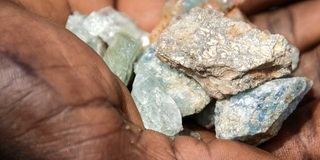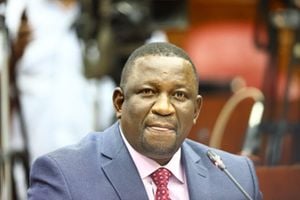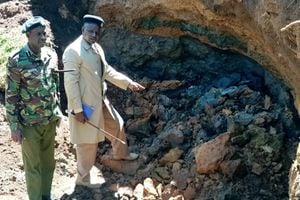
A resident displays samples of precious stones extracted at a mining site in Kiangunguru village, Embu County, on February 2, 2024.
Embu County was hit with a palpable sense of excitement in January with the announcement that deposits of the precious rare earth mineral, Coltan, had been discovered in the area.
However, residents of the remote Kiangangaru village in Kiambere Ward were rather bemused, for they had for years been collecting from the surface quantities of the grey rock and selling to middlemen for a pittance without knowing that they were literally living atop the proverbial gold mine.
Meanwhile, in Western Kenya, Kakamega County has emerged as nerve centre of renewed gold prospecting and mining projects.
Shanta Mining Ltd, the firm that won concessions in 2022, described its findings so far “believed to be among the highest grading gold projects in Africa”.
The new findings offer fresh hope in the mining sector following depletion of the titanium resources in Kwale County that are forcing Tiomin Resources Inc to close shop after 10 years of operations.
The company has, however, established potential prospects for high quality titanium ore in other parts of Kwale, as well as Tana River, Lamu and Taita Taveta counties.
It has five mining applications pending. Kakamega and surrounding regions including Vihiga and Siaya and Migori counties have long held gold resources, believed to have been largely depleted by the dawn of independence.
There was the famous Kakamega Gold Rush of the 1880s, while the name of the town of Ikolomani is believed to have derived from ‘Gold Mine’.
Over the past decades, gold mining in the region has been largely been left to small-scale miners going underground into dangerous makeshift pits that occasionally cave-in, or panning on river beds.
Fresh large-scale exploration by Shanta Mining, a company active in neighbouring Tanzania and quoted on the London Stock Exchange, has spurred intense interest in the region. Gold may well be an old story earning a new lease of life, whole Coltan in Embu and other regions presents new frontiers in minerals that are vital to new technology in such as cellphones.
Almost every kind of electronic device including computers, printers, cameras and other miniaturised electronic circuits such as hearing aids, heart pacemakers, automobile computers and others need products with elements from Coltan, so do high-temperature alloys for jet engines.
Also Read: Illegal sand harvesting ravages Kitui rivers
It is estimated that pending orders for Airbus and Boeing aircraft will greatly increase demand for Coltan in coming years.
Soon after the Coltan in Embu announcement by the Cabinet Secretary for Mining, Blue Economy and Maritime Affairs Salim Mvurya, a team of experts already engaged in a massive mapping exercise of mineral resources in the country was deployed to fast-track on the ground verification of the quantity, expanse, quality and commercial worth of the Coltan that in Embu that had first been officially determined through aerial surveys.
The air mapping exercise had also established Coltan finds in six other counties, which if confirmed and found commercially viable could transform Kenya into a mineral Eldorado.
Other counties with Coltan finds so far are Tana River (Kora Wells), Kitui (Mwingi North), Samburu (Nachola Area), Turkana (Loima and Makutano) and West Pokot (Alale).
However, expectations that Embu County was set for a mineral-led economic boom were rather premature.
The multi-agency team sent to verify the mineral deposits was given one month to report back, but that was a rather ambitious target as a full-scale survey can take a long time before the scale of actual deposits is established, and yet more lead time concessioning, the issue of exploration and mining licenses.
While there has been small scale surface mining of Coltan in Embu and some underground trade in the mineral, Mr Mvurya and his Principal Secretary Elijah Mwangi highly doubt that there has been significant illegal mining or exports.
Resource factor
Unlike precious metals such as gold and precious stones such as diamonds and rubies, Coltan is crude ore that requires significant processing of large quantities to produce just minute quantities of the precious mineral.
With no known processing plant in the country, indeed in the entire region including Democratic Republic of Congo which has some of the world’s biggest reserves, raw ore would have to be shipped out in massive quantities by through the port of Mombasa.
The ministry already has special police unit established to crack down on illegal mining and trade in precious metals and minerals, and surveillance at the Port shows no unusual activity.
In a conversation with The Weekly Review at the Ministry headquarters last week, Mvurya and Mwangi remained cautiously optimistic that Kenya could be on the verge of a major revolution in the mining sector.

Cabinet Secretary for Mining, Blue Economy and Maritime Affairs Salim Mvurya
The ministry targets an increase of mining’s contribution to the national economy from around 1 per cent to at least 10 per cent.
The target is informed by an ongoing national survey, through aerial reconnaissance followed by ground verification, which is establishing suspected presence of previously undiscovered deposits in many parts of the country.
Once the survey is completed, a preliminary report expected in June is expected to produce the first update of the national minerals map since the last one was published more than ten years ago.
Mvurya remains extremely hesitant to talk about expected value of underground resources until the surveys are completed, ground explorations carried out and prospecting commences, but one can read the unmistakable signs on hope on his face as he talks about a previously under-resourced ministry playing a vital role in the national economy.
He is also aware of false hopes from the past when massive mineral finds turned out to be duds.
One that he will not talk about, it is not in his docket, is the reported oil finds in northern Kenya which promised to make the country a major oil exporter, only for activities by Tullow Oil to halt without explanations either for the company or the Ministry of Petroleum.
Then there was the reported discovery 10 years ago of vast deposits of niobium, a close relative of coltan, in the Mrima Hills in Kwale County.
The sensational find reported in 2013 worth an estimated Sh6.25 trillion would have made Kenya a mineral superpower.
But everything fizzled out when the exploration and mining rights granted through political connections with a local fixer, controversial businessman Jacob Juma, were revoked by the new government of President Uhuru Kenyatta.
The mining license had been rushed through in a very opaque process during the transition period between the exit of President Mwai Kibaki and assumption of office of Kenyatta and Deputy President William Ruto.
When then Mining Minister Najib Balala revoked the licences, Juma’s Cortec Mining Limited went to court, but its various applications were thrown out on finding that the licences had been issued illegally.
It also transpired that the company did not properly drive its case in court, with Juma reportedly trying to seek political intervention, which was rebuffed, from then Deputy President William Ruto.
A suit against the government filed at the International Centre for Settlement of Investment Disputes was also thrown out in 2021.
Juma, who was believed to be a front from a major business and political wheeler-dealer, was killed in a dramatic roadside ambush in 2016 when his armoured Mercedes Benz limousine was blocked and windows blown open by assailants believed to have been either state security operatives or professional hit men.
The police have never reported any progress on the investigations.
Indeed, one issue the Ministry must tackle is the legendary corruption associated with mining.
Almost form the time Kenya vast discovered valuable minerals after independence, mostly ruby, green garnet, tsavorite and other precious stones in the Taita-Taveta region, mining became preserve of the ruling class.
International media widely reported in 1974 and 1975 that the American prospectors who discovered precious stones in Taita Taveta were swiftly deported and the mines forcibly taken over by the family and associates of then President Mzee Jomo Kenyatta.
The matter caused a diplomatic rift between Nairobi and Washington.
While Mvurya insists that the new Mining Policy will ensure transparency and fair play in the issuance of prospecting, exploitation, processing and export licences, powerful political interests could still intervene to have way. Another issue is the real value of minerals to Kenyans.
Kenya was getting only 5 percent in royalties from the titanium mined and sold by Tiomin Resources. Royalties from gold in Kakamega are also set at 5 percent.
Also Read: Streamline mining sector
Of that amount, 20 percent is meant to be reserved for local communities, to be shared between the County government and direct community projects.
However, during the lifetime of Tiomin operations in Kwale County, not a cent in royalties went to the host communities. Mvurya concedes that the money was received by the central government but not remitted for lack of a policy document on how the finds will be shared and used. The policy, he says is now ready, but that might be little comfort to locals who thought they would be enjoy part of the riches but remained in abject poverty.
The Ministry surveys establish there is niobium in Mrima Hills, but Mrima remains mystified by the sensational amounts and values reported in 2013 as no detailed exploration had been carried out.
He recounts how many briefcase operators have in the past secured mining licences, then inflated the values of their prospects to sell on their concession to third parties, or increase their value on stock exchanges in London, Toronto, Shangai and other capital markets.
To curb such mischief, the Ministry has updated a Mining Policy to ensure that only bona-fide investors with the requisite resources, experience and history can get prospecting and mining licences.
They have also instituted, to borrow from Rugby Scrummage convention, the “use it or lose it” policy so that companies securing rights must commence exploration and mining within specified time frames.
The policies also include protection and support for local small scale miners.
“In the past we treated them as criminals”, says Mvurya, but now they are being encouraged to register and group into cooperatives. That way they can get help in terms of testing, grading and verifying their produce, entry into the formal market, upgrading of equipment and advice on safety.
Meanwhile, local gold miners in the small Isulu-Bushiangala villages in Kakamega, the main prospects identified so far, will be able to benefit from a laboratory being set up by the government as well as a Sh5.6 billion processing factory being out by Shanta Gold.
The company is also exploring prospects in Ramula, Miruka, Ochegue and Anomaly 22, which it says all show great potential. Company filings say Kimingini is an advanced-stage target close to Isulu-Bushiangala, while the colonial area Rosterman mines are beign looked at afresh. Other nearby areas of interest include Barding-Masumbi, Aila, Nairobi Hill and Viyalo.
Government surveys have also established significant gold reserves Turkana, West Pokot, Marsabit and Isiolo counties, all awaiting exploitation by private sector investments. Vihiga, Kakamega and Kisumu counties also have huge granite resources that are “world-class in hardness and texture” according to Ministry findings.
An investor has already been identified to put up a granite cutting and polishing Centre at Vihiga, expected to start construction before July with an investment over Sh2.5 billion in the plant and support infrastructure.
The defunct Fluorspar mining in Kerio Valley is also being revived.
Beyond the 10 hectares or so mined by the Fluorspar Mining company that was controversially taken over by former Cabinet minister Nicholas Biwott in the 1990s, new findings indicate tenfold the known reserves. A British firm has secured rights to revive fluorspar mining in the Kimwarer area of Elgeyo Marakwet county with a Sh4.8 billion investment expected to roar to life in a few months.
Other minerals such as Copper are known to occur in economically viable quantities in Kitui, Embu, Migori, Tharaka Nithi, Samburu and West Pokot.
Deposits are currently being exploited on small scale by artisanal miners and exported raw, but plans are in place commercial exploitation and local processing.










